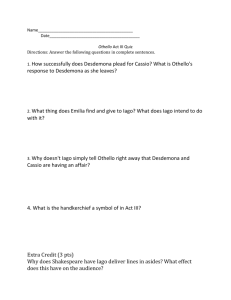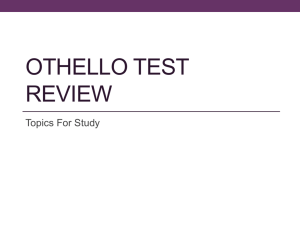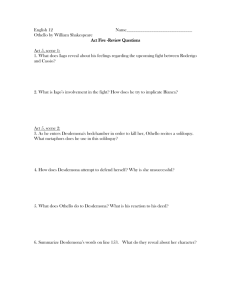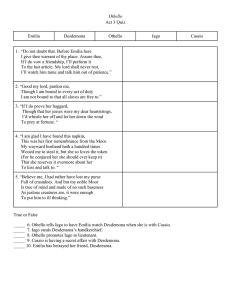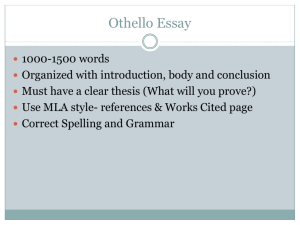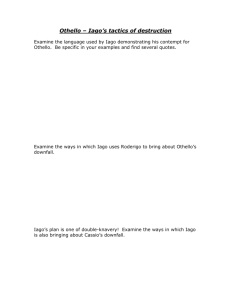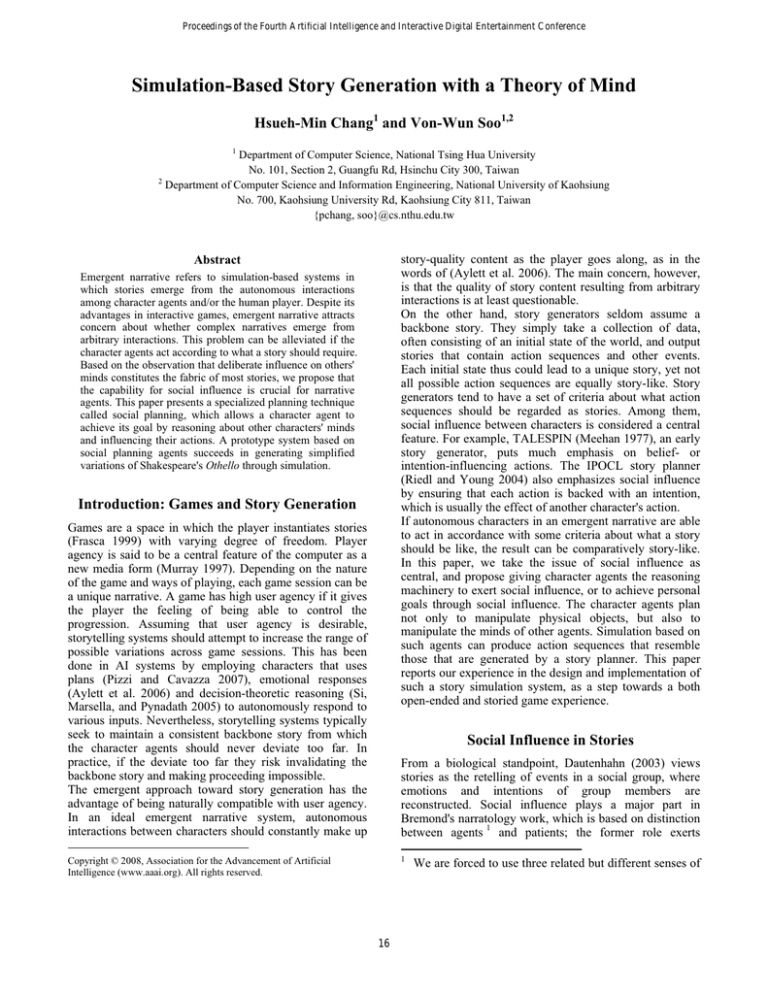
Proceedings of the Fourth Artificial Intelligence and Interactive Digital Entertainment Conference
Simulation-Based Story Generation with a Theory of Mind
Hsueh-Min Chang1 and Von-Wun Soo1,2
1
Department of Computer Science, National Tsing Hua University
No. 101, Section 2, Guangfu Rd, Hsinchu City 300, Taiwan
2
Department of Computer Science and Information Engineering, National University of Kaohsiung
No. 700, Kaohsiung University Rd, Kaohsiung City 811, Taiwan
{pchang, soo}@cs.nthu.edu.tw
story-quality content as the player goes along, as in the
words of (Aylett et al. 2006). The main concern, however,
is that the quality of story content resulting from arbitrary
interactions is at least questionable.
On the other hand, story generators seldom assume a
backbone story. They simply take a collection of data,
often consisting of an initial state of the world, and output
stories that contain action sequences and other events.
Each initial state thus could lead to a unique story, yet not
all possible action sequences are equally story-like. Story
generators tend to have a set of criteria about what action
sequences should be regarded as stories. Among them,
social influence between characters is considered a central
feature. For example, TALESPIN (Meehan 1977), an early
story generator, puts much emphasis on belief- or
intention-influencing actions. The IPOCL story planner
(Riedl and Young 2004) also emphasizes social influence
by ensuring that each action is backed with an intention,
which is usually the effect of another character's action.
If autonomous characters in an emergent narrative are able
to act in accordance with some criteria about what a story
should be like, the result can be comparatively story-like.
In this paper, we take the issue of social influence as
central, and propose giving character agents the reasoning
machinery to exert social influence, or to achieve personal
goals through social influence. The character agents plan
not only to manipulate physical objects, but also to
manipulate the minds of other agents. Simulation based on
such agents can produce action sequences that resemble
those that are generated by a story planner. This paper
reports our experience in the design and implementation of
such a story simulation system, as a step towards a both
open-ended and storied game experience.
Abstract
Emergent narrative refers to simulation-based systems in
which stories emerge from the autonomous interactions
among character agents and/or the human player. Despite its
advantages in interactive games, emergent narrative attracts
concern about whether complex narratives emerge from
arbitrary interactions. This problem can be alleviated if the
character agents act according to what a story should require.
Based on the observation that deliberate influence on others'
minds constitutes the fabric of most stories, we propose that
the capability for social influence is crucial for narrative
agents. This paper presents a specialized planning technique
called social planning, which allows a character agent to
achieve its goal by reasoning about other characters' minds
and influencing their actions. A prototype system based on
social planning agents succeeds in generating simplified
variations of Shakespeare's Othello through simulation.
Introduction: Games and Story Generation
Games are a space in which the player instantiates stories
(Frasca 1999) with varying degree of freedom. Player
agency is said to be a central feature of the computer as a
new media form (Murray 1997). Depending on the nature
of the game and ways of playing, each game session can be
a unique narrative. A game has high user agency if it gives
the player the feeling of being able to control the
progression. Assuming that user agency is desirable,
storytelling systems should attempt to increase the range of
possible variations across game sessions. This has been
done in AI systems by employing characters that uses
plans (Pizzi and Cavazza 2007), emotional responses
(Aylett et al. 2006) and decision-theoretic reasoning (Si,
Marsella, and Pynadath 2005) to autonomously respond to
various inputs. Nevertheless, storytelling systems typically
seek to maintain a consistent backbone story from which
the character agents should never deviate too far. In
practice, if the deviate too far they risk invalidating the
backbone story and making proceeding impossible.
The emergent approach toward story generation has the
advantage of being naturally compatible with user agency.
In an ideal emergent narrative system, autonomous
interactions between characters should constantly make up
Social Influence in Stories
From a biological standpoint, Dautenhahn (2003) views
stories as the retelling of events in a social group, where
emotions and intentions of group members are
reconstructed. Social influence plays a major part in
Bremond's narratology work, which is based on distinction
between agents 1 and patients; the former role exerts
1
Copyright © 2008, Association for the Advancement of Artificial
Intelligence (www.aaai.org). All rights reserved.
16
We are forced to use three related but different senses of
influence on others while the latter is subjected to
influence. ((Bremond 1973) referenced from (Cavazza and
Pizzi 2006)). A story is mainly the interaction between the
patient and the agent, although a character can be both an
agent in a relationship and a patient in another one, and a
patient may be motivated to become an agent.
Computational application of Bremond's theory would
require characters to be capable of social influence, which
in turn requires formal understanding about how others
think; such understanding is commonly known as a theory
of mind, such as in (Si, Marsella, and Pynadath 2005) and
(Dautenhahn 2003).
Although social influence could happen with any set of
motivated characters capable of being influenced,
Bremond's theory requires the influence to be deliberate;
the story has to progress along the plan of the agent to
influence the patient, e.g. to make him or her show
affection, give money or self-destruct. Random actions can
influence characters, but appear less strongly story-like.
AI Model of Narrative Sequences
The prominence of social influence is also evident from the
structure of the narrative sequence. AI-based research often
understands stories as causally related sequence of events;
an explicit treatment can be found in (Swartjes and Theune
2006). For the purpose of this paper, it is useful to dissect a
story into causal subsequences and problem-solving
subsequences. A causal sequence is defined as a chain of
actions in which any later action is motivated by a former
one. The motivation factor can be emotion, personal
motives and/or social commitment. Emotion-based story
systems tend to rely on causal sequences to a greater
degree, as the storyline progresses from actions and
reactions. On the other hand, a problem-solving sequence
is a chain of actions in which any latter action is enabled
by a former action, and all actions together satisfy a goal.
In other words, it is a plan carried out.
A simple story structure can consist of a causal sequence in
which each action is replaced by a problem-solving
sequence (PSS):
motivates
motivates
[PSSA] —o [PSSB] —o [PSSC]……
In elaborated stories, however, causal sequences can be a
part of problem-solving sequences instead, such as the
following:
Figure 1: Schematization of Iago’s social plan.
the problem by influencing the actions of B as a means to
achieve the goal of his own. Agents who produce such a
plan (and thus, such a story) need to understand how the
emotion, motives and social commitment of other agents
work. In other words, they must possess and use a theory
of mind.
Social Influence in Othello
Shakespeare's play Othello is a remarkable example
highlighting the above-mentioned structure. Since we will
use a simplified version as the case study throughout this
paper, a description is warranted.
A soldier Iago had long resented General Othello and
plotted to make him suffer by having him kill his own wife,
Desdemona. To carry out his plan, Iago first asked his wife
Emilia in the garden to steal a handkerchief Othello gave
Desdemona. Emilia stole it from Desdemona and gave it to
Iago. Iago then deliberately planted the handkerchief in
the lieutenant Cassio's residence, expecting that Cassio
would pick it up, and Cassio did it. Othello, under the
advice of Iago, then paid a visit to Cassio. Seeing the
handkerchief on Cassio, he was enraged by jealousy. He
killed Cassio immediately and ended up going to
Desdemona's bedroom to kill her as well.
The structure of the Othello narrative sequence is depicted
in figure 1. The overall story is one problem-solving
sequence of Iago, but problem-solving involves motivating
Emilia, Cassio and Othello to complete parts of the task. In
causal subsequence (1), request motivates compliance. In
(2), dropping a handkerchief motivates holding. In
subsequence (3)-(4)-(5), invitation motivates visit, which
in turn causes jealousy and murder. The causal
subsequences in turn contain problem-solving subsubsequences, resulting in a rather delicate structure.
motivates
enables
[ ActionA1o ActionB1 o ActionA2] = PSSA
Actions in the box form a causal sequence. This structure
characterizes deliberate social influence, because A solves
the word agent. In the AI sense, an agent is a piece of
software that not only thinks but also acts. In the literary
sense, it is one who exerts influence in contrast to the
influenced counterpart. In a sociological sense (as in user
agency), an agent is an initiator of change in a real or
fictional society. There should be little confusion however.
17
act on the physical environment.
Planning to Influence Others
• Belief effects b-effects(act, ag) of an action act on the
In this section we describe the design and implementation
of software agents that plan to influence others. The agents
successfully reconstruct a simplified version of Othello as
described in the previous section. The simulation system is
not yet interactive, but can serve as a demonstration of how
social planning works.
target agent ag are the changes of ag's belief after it
perceives p-effects(act).
• Goal effects g-effects(act, ag) are the changes of ag's
goals after it perceives p-effects(act).
Belief and goal effects are dynamic in nature. They are
inferred from the mental rules of others and the spatial
relation between the actor and the target and cannot be
determined offline. The total effect of an action is the
union of the three types of effects.
On the precondition side, an action must be intended to be
performed. The planning agent is free to intend any action,
but actions of others must be explicitly motivated. An
action is intended if the performer intends some of the
effects of the action. Thus,
• Intentional precondition i-precond(act) =
self(act.performer)
(goals(act.performer) effects(act) ).
Note that we strictly stick to the basic set of operators used
by non-social domains, without introducing any new
operator specialized for social influence. Only the context
determines whether an operator is social or non-social. A
social plan is thus one in which the intentional
precondition of every action is satisfied with the goal
effects of other actions or the initial state. Additional
formalisms for social plans can be found in (Chang and
Soo 2008).
Table 1: Belief revision/motivation rules for the Othello scenario.
Source
Motivational Rules
Personal
motive
Greed: self(?s) at(?s, ?l) at(?o, ?l)
precious(?o) o holds(?s, ?o)
Curiosity: self(?s) befriends(?s,
request(?a, ?s, at(?s, ?l)) o at(?s, ?l)
?a)
Emotion
Jealousy: self(?s) loves(?s, ?a) loves(?a, ?b)
odead(?a) dead(?b)
Social
disposition
Obedience: self(?s) loves(?s, ?a) request(
?a, ?s, holds(?a, ?o)) o holds(?a, ?o)
Belief Revision Rules
Folk psychology: isGiftFrom(?g, ?a) isGiftTo(?g, ?b)
holds(?c, ?g) ((woman(?b) man(?c)) (man(?b)
woman(?c)) o loves(?b, ?a) loves(?b, ?c)
Model of Characters with Motivation
Characters are modeled as software agents with explicit
beliefs and goals. They occupy a shared environment, in
which the effects of their actions can be perceived by
others. Actions include physical ones and communicative
acts such as request and inform. The agents use rules to
update their mental state according to perception. Beliefrevision rules decide how beliefs are updated with new
percepts, while motivation rules decide how goals are
generated from beliefs. The rules also cover
communicative actions including request and inform. Once
adopting a new goal, an agent plans for it. Table 1 shows
the rules that appear in the Othello scenario. These rules
are exactly how the characters deliberate during the
Othello simulation. For example, the Greed motivation rule
in personal motives says that an agent encountering a
precious object will be motivated to hold it. These rules are
exactly how the characters deliberate during the simulation.
How Social Planning Agents Work
Social planning, formulated this way, thus involves
dynamically deducing the belief and goal effects and
matching them against the intentional preconditions. Our
technique relies on automatic translation of a non-social
world description and knowledge about other agents to a
social planning domain written in the Planning Domain
Description Language (PDDL). A general-purpose PDDL
planner then solves the generated problem. Describing
planning problem requires two PDDL documents, a
domain file and a problem file; the former describes
predicates and actions while the latter records the initial
state. Since version 2.2 (Edelkamp and Hoffmann 2004),
PDDL provides a derived predicates construct, which
defines predicates that can be deduced from other
predicates but cannot be direct effects of any action.
Mental predicates, including beliefs and goals, obviously
fall into this category because they always follow from
physical effects. Any attempt to change the mental
predicates must be mediated by the physical environment,
and the result can only be inferred, as (Field and Ramsay
2006) has pointed out.
Compiling domain knowledge into PDDL thus involves
specifying deduction of belief predicates and goal
predicates in the domain file, and dumping knowledge
about the mind of others into the problem file. A PDDL 2.2
compatible planner can then infer the belief goal and
effects according to the execution context. The architecture
Model of Social Plans
We define a social plan as one that includes any number of
actions by other agents (which we term foreign actions), as
opposed to non-social plans that contains only actions of
self. Since incorporating foreign actions requires first
motivating them, a revision of planning operators is
required. In a social domain, actions modify not only the
physical environment, but also the minds of agents. Belief
effects, goal effects and intentional preconditions are
defined to reflect the mental part of operators.
• Physical effects p-effects(act) are the effect of the action
18
goals of others may need multiple actions to achieve,
necessitating that a goal effect supports not just an action
but a whole plan of some other agent. As expressing such
support in PDDL per se is problematic, we define macro
actions as the repertoire of plans one may get another agent
to conduct. Macro actions represent common recipes of
actions in the form of a plan library. Their use may
increase plot familiarity and planning speed, but may also
reduce the number of possible social manipulation
strategies. In the Othello scenario, Emilia's plan in (1) and
Othello's plan in (5) are represented as macro actions for
Iago, although Emilia and Othello do plan for their goals
themselves during simulation.
Figure 2: Architecture of the social planning agent.
Social Plan Execution
of the social planning agent depicted in figure 2. Following
subsections describe the details about domain compilation.
Location Reasoning. Controlling the perception of other
agents is the first step toward controlling the social
consequences of an action. Whether the effect of an action
is perceived or not depends on the relative location
between the performer and the witness. The domain
compiler models percepts as conditional effects of an
action. They will be generated only when the action is
performed within the perceptual range of another agent, so
that the action performer knows where to perform an
action to achieve the desired effect. Moreover, actions
involving location change has additional perceptual effects:
the agent in the new location perceives everything
perceivable in that location, and vice versa. An action also
generates perceivable action events.
Reasoning about Belief and Motivation. For a character
agent a who tends to be folk-psychological, the rule in
table 1 is a belief revision rule. For another character who
know that a is folk-psychological, the same rule becomes a
theory of mind. A belief predicate thus can be derived from
two sources: direct perception, and belief revision rules.
The belief_loves(a, b, c) predicate (=PDDL form for
believes(a, loves(b, c)) has the following definition:
believes(a, loves(b, c)) perceives(a, loves(b, c))
( folk-psychological(a)
(gift, d) ( believes(a, isGiftFrom(gift, d))
believes(a, isGiftTo(gift, b))
believes(a, holds(c, gift)) … ) )
In practice, however, love is an unperceivable predicate
and will be excluded from the definition. Goal predicates
are
similarly
derived
from
motivation
rules.
Communicative actions are treated no differently from
physical actions. Their performance produces action events
as effects, which invoke the matching belief revision and
motivation rules. For each physical predicate, the domain
compiler generates a corresponding belief predicate and a
goal predicate, as PDDL derived predicates.
Intentional Precondition and Macro Action. The
intentional precondition of an action is generated exactly
the same as the definition of i-precond(act) above. Now
social planning can work by using goal effects to satisfy
intention preconditions, with one remaining problem: some
Agents executing non-social plans need only to check
whether the precondition of the next action is true before
performing it. However, social plans raise some additional
complications that must be dealt with.
1. As stated, the belief and goal effects of an action are
context-dependent due to reliance on derived predicates
and conditional effects. A post-processor therefore must
reconstruct the actual precondition and (mental) effects of
actions after the plan is produced and before it is put to
execution. Moreover, it must reconstruct the relation
between a specific effect and the conditions that the effect
requires, because it is possible that an action does not
achieve the desired effect. For example, if Cassio travels
elsewhere during Iago's plan, the handkerchief can still be
dropped, but doing so accomplishes no goal because
Cassio is not there to pick it up. An agent thus must ensure
the particular conditions for the intended effect hold before
performing an action.
2. Unlike self actions, foreign actions may take place
somewhere outside the planning agent's range of
perception, leaving the planning agent unaware of whether
the effect has been realized or not. Our current solution is
to insert goto actions during post-processing to monitor if a
foreign action has taken place. For example, after telling
Othello to visit Cassio, Iago should go to Cassio's
residence to make sure things happen as he predicted.
3. A social plan may fail, in that some other agents do not
actually perform the expected action. When, how and if
they will eventually perform it is not always certain. A
completely sensible solution can be difficult. Our current
naïve solution is just to wait for several ticks, and deem it a
failure after timeout. However, if social plan failure is due
to an incorrect model of others, a new plan may still fail at
the same spot. A better solution would be a diagnosis of
the belief model to repair wrong assumptions about others.
Implementation and Experiences
System Construction
The social planning agent depicted in figure 2 is fully
implemented, using Optop (McDermott 2004) as the
19
PDDL planner, as Optop is the only tested planner that
reliably solves problems with derived predicates and
conditional effects. The multi-agent simulation platform
runs on JADE, which talks to Lisp-based Optop via sockets.
The agent platform contains an ontology layer that
dynamically annotates the physical environment in OWL,
as described in (Chang et al. 2005). Attempts to integrate
the system with a Java-based 3D engine are underway.
The reason is that one has more instruments to achieve a
goal when others are easier to motivate. For example, if
Iago is unable to kill, the goal dead(Othello) is impossible,
until we added a new rule allowing everyone to ask for the
death of another. Iago then devised the plan to ask Emilia
to desire Othello's death, invite Othello to the garden, and
let Emilia kill him. However, motivation sensitivity can
also degrade the story by making goals too easily
achievable. For example, with the new rule above, Iago can
easily ask Othello to kill Desdemona and complete the task
of the original story, losing most of the intrigue. A more
systematic experimental investigation about the tradeoff
between story possibility and quality is being planned.
Related Work
The general idea of social planning comes from
(Castelfranchi 1998), whose theory identifies social actions
as ones that are performed in awareness of other agents
and/or to change their minds. The conversation planner by
(Field and Ramsay 2006) models effects of a speech act as
indirect ramifications and considers the latter normal in
communications. Their planner is coupled with a theorem
prover to derive the belief effects, but does not address
goals and social manipulation.
It is common that interactive storytellers are also story
generators to a certain degree. A number of them have
already taken social influence into account. Thespian (Si,
Marsella, and Pynadath 2005) is remarkable in that its
agents employ a theory of mind to decide actions. Unlike
social planning agents, however, Thespian agents are based
on decision-theoretic reasoning. A Markov model
simulates some steps of lookahead, so that the agents can
decide on the action with the highest expected utility.
Despite the advantages of being able to simulate the world
and derive utilities, Thespian's decision-theoretic approach
may not scale as well as planners, and the maximum
lookahead is limited at 2, as opposed to Iago's 14-step plan.
This results in a tendency of Thespian stories to rely more
on causal sequences than problem-solving ones, as shown
in their own examples.
Pizzi and Cavazza's storyteller for the Madame Bovary
scenario puts particular focus on the mental side of a story
(Pizzi and Cavazza 2007). The system makes use of
explicitly mind-influencing planning operators. As
opposed to physical operators which modify the
environment, an interpretation operator modifies the mind
of self, while a character interaction operator modifies the
mental state of others. For the purpose of story generation
(which is not the exact purpose of their system), this
distinction can be too rigid for two reasons. First, the
character interaction operators modify only relational
fluents, such as the target character's affinity towards the
performer, but not all mental predicates in general,
resulting in limited ability for social manipulation. Second,
the distinction prevents agents from using physical
operators for character interaction purposes through
stigmergy
(environment-relayed
communication),
Figure 3: Character mental state editor.
Scenario Setup
We developed a character mental state editor, which is
shown in figure 3. The editor reads the domain ontology in
OWL beforehand and then allows a human designer to edit
the characters' beliefs and intentions according to the
ontology. The editor also allows for the specification of
beliefs and intentions about others' beliefs and intentions.
To make the character agents produce a plot exactly like
that in figure 1, we made Iago the sole social planning
agent, while Cassio, Desdemona, Emilia, and Othello are
non-social planning agents who do not deliberately
influence others. Iago knows the mental state of all other
characters and their personalities as well, such as Othello
being curious and jealous and Emilia being obedient. The
plot is successfully reproduced after a few tweaks, which
are explained below.
Preliminary Results
One main concern is whether the system can generate new
stories. Before we can reproduce the Othello story, some
faults in the domain already lead to alternate stories, one of
which results from not adding the conjunct
intends(Othello, dead(Iago)) to the goal. Without that
conjunct, Iago will simply visit Othello while holding the
handkerchief. Doing so motivates Othello to kill not only
Desdemona, but Iago himself as well. Another deviation
occurs when we specified the goal as dead(Desdemona), in
that case Iago would simply go and kill Desdemona.
An intuitive observation is that motivation sensitivity
positively corresponds to possibility of story emergence.
20
Pacific Rim Workshop for Multi-Agents (LNAI series),
forthcoming. Springer-Verlag.
exemplified by Iago's drop action.
IPOCL (Riedl and Young 2004) is a story planner that
plans actions for all agents in the scenario. Despite that
IPOCL is not based on simulation, it does share some
methodological similarity with social planning, in that it
ensures the intention behind each action is either motivated
by another action or already in the initial state. However,
social planning uses a more sophisticated model of other
autonomous agents that allows reasoning about their
perception, belief update and motivation rules, while
IPOCL relies on operators that directly introduce an
intention into an agent. On the other hand, an important
advantage of the IPOCL algorithm is that it does not rely
on macro actions, which are needed by the PDDL-based
approach to social planning.
Chang, P. H.-M., Chen, K.-T., Chien, Y.-H., Kao, E., and
Soo, V.-W. 2005. From Reality to Mind: A Cognitive
Middle Layer of Environment Concepts for Believable
Agents. In Weyns, D., Parunak, H. V. D., and Michel, F.
eds. Environments for Multi-Agent Systems (LNAI 3374),
57-73. Springer-Verlag.
Dautenhahn, K. 2003. Stories of Lemurs and Robots – The
Social Origin of Story-Telling. Chapter 4 in Mateas, M.,
and Sengers, P. eds. Narrative Intelligence. Amsterdam:
John Benjamins.
Edelkamp, S., and Hoffmann, J. 2004. PDDL2.2: The
Language for the Classical Part of the 4th International
Planning Competition. Technical Report 195, AlbertLudwigs-Universität, Institut für Informatik, Freiburg,
Germany.
Conclusion
The ability of character agents to influence others socially
is the key to the sophistication of emergent narratives.
Modeling characters as software agents that understand
others' minds enables them to become literary agents who
exert influence on a patient. Social planning allows
character agents to build plans upon other characters'
actions by reasoning about how to motivate them. Our
multi-agent story system, based on social planning
characters, demonstrates that sophisticated stories can be
generated from multi-agent simulation.
Field, D., and Ramsay, A. 2006. How to Change a Person's
Mind: Understanding the Difference between the Effects
and Consequences of Speech Acts. In Proceedings of the
5th Workshop on Inference in Computational Semantics,
27-36.
Frasca, G. 1999. Ludology Meets Narratology: Similitude
and differences between (video)games and narrative.
http://www.ludology.org/. Original Finnish version: 1999.
Ludologia kohtaa narratologian. Parnasso 3: 365-371.
McDermott, D. 2004. The Optop Planner. In Fourth
International Planning Competition Booklet (IPC'04).
Acknowledgement
Meehan, J. R. 1977. TALE-SPIN: An Interactive Program
That Writes Stories. In Proceedings of the 5th Joint
Conference on Artificial Intelligence, 91-98.
This work is supported by the National Science Council of
Taiwan under grant number NSC 96-2628-E-007-044MY3. The authors appreciate the comments from
anonymous reviewers.
Murray, J. H. 1997. Hamlet on the Holodeck: The Future
of Narrative in Cyberspace. New York: The Free Press.
Pizzi, D., and Cavazza, M. 2007. Affective Storytelling
Based on Characters' Feelings. In Proceedings of the 2007
AAAI Fall Symposium on Intelligent Narrative
Technologies.
References
Aylett, R. S., Figuieredo, R., Louchart, S., Dias, J., and
Paiva, A. 2006. Making It Up As You Go Along Improvising Stories for Pedagogical Purposes. In
Proceedings of the 6th International Conference for
Intelligent Virtual Agents (LNAI 4133), 307-315. SpringerVerlag.
Riedl, M. O., and Young, R. M. 2004. An Intent-Driven
Planner for Multi-Agent Story Generation. In Proceedings
of the Third International Joint Conference on
Autonomous Agents and Multiagent Systems, 186-193.
Washington DC: IEEE Computer Society.
Bremond, C. 1973. Logique du Recit. Paris: Editions du
Seuil. (in French)
Si, M., Marsella, S. C., and Pynadath, D. V. 2005.
Thespian: Using Multi-agent Fitting to Craft Interactive
Drama. In Proceedings of the Fourth international Joint
Conference on Autonomous Agents and Multiagent
Systems, 21-28. New York: ACM Press.
Castelfranchi, C. 1998. Modeling Social Actions for AI
Agents. Artificial Intelligence 103(1-2): 157-182.
Cavazza, M., and Pizzi, D. 2006. Narratology for
Interactive Storytelling: A Critical Introduction. In
Proceedings of the 3rd International Conference on
Technologies for Interactive Digital Storytelling and
Entertainment (LNCS 4326), 72-83. Springer-Verlag.
Swartjes, I., and Theune, M. 2006. A Fabula
Emergent Narrative. In Proceedings of
International Conference on Technologies for
Digital Storytelling and Entertainment (LNCS
60. Springer-Verlag.
Chang, H.-M., and Soo, V.-W. 2008. Planning Actions
with Social Consequences. In Proceedings of the 10th
21
Model for
the 3rd
Interactive
4326), 49-


